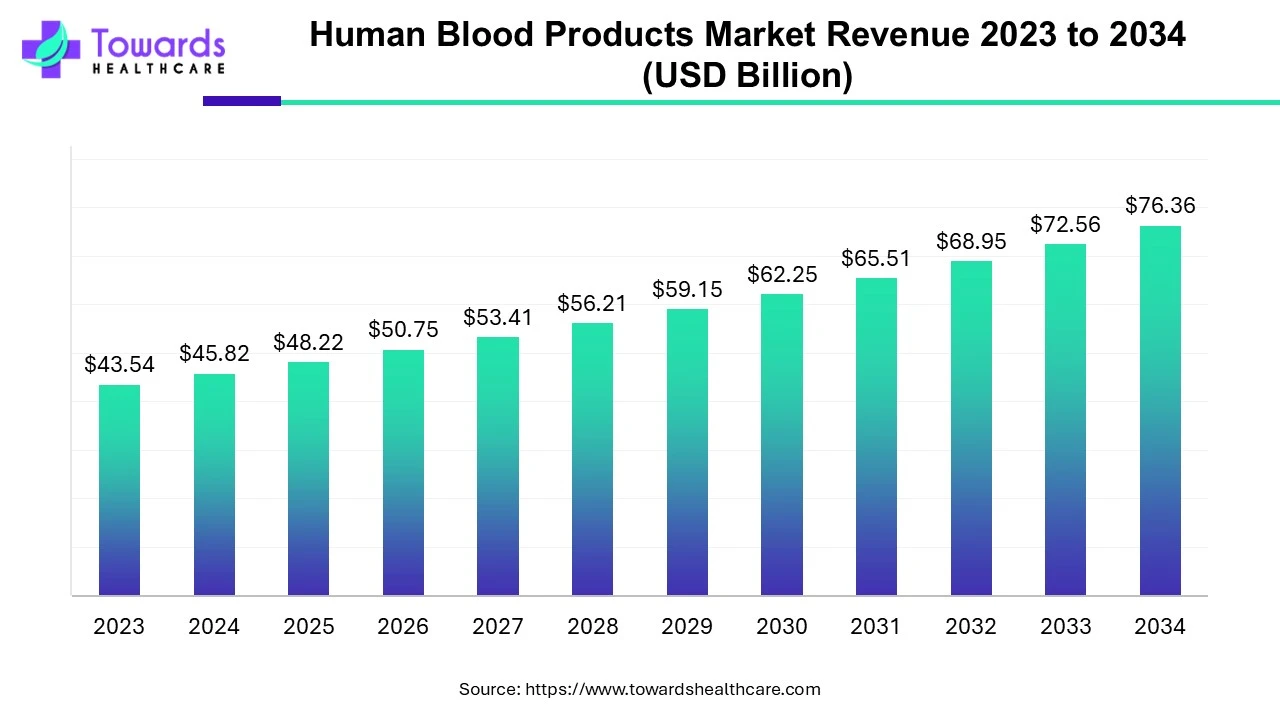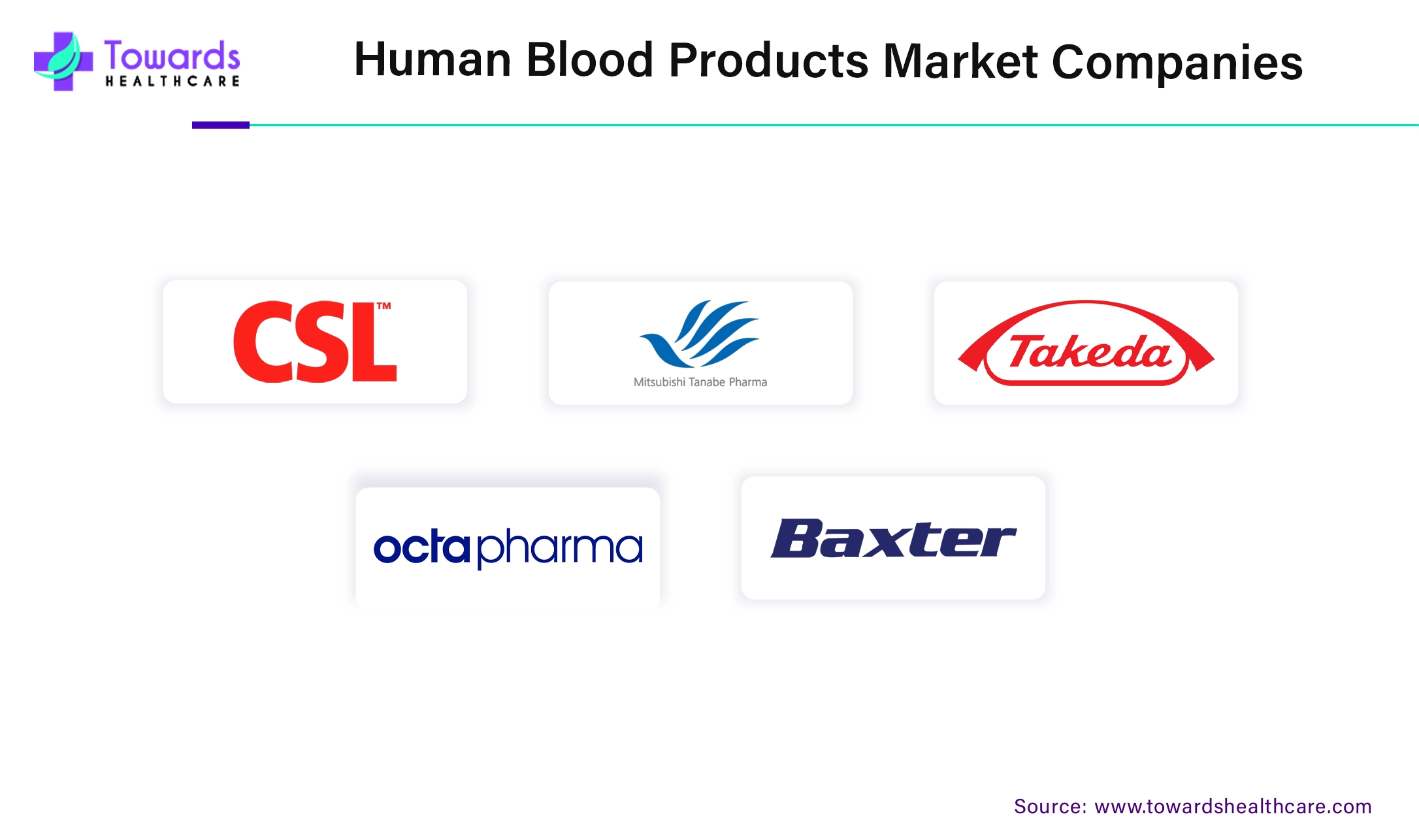March 2025


Principal Consultant

Reviewed By
The global human blood products market size was estimated at US$ 43.54 billion in 2023 and is projected to grow to US$ 76.36 billion by 2034, rising at a compound annual growth rate (CAGR) of 5.24% from 2024 to 2034. The demand for blood and blood components is very high in the healthcare industry because whole blood and blood components are used during various health issues.

The human blood products market deals with the collection, sorting, and storing of human blood and components derived from it. Whole blood, platelets, cryo, RBCs, WBCs, plates, and plasma are the different products that are collected via blood donation camps and centers. The blood and blood components are used for different purposes depending on the specific needs. For instance, in the cases of severe blood loss due to accident, during surgeries, or during childbirth, whole blood is transfused. In the case of malaria or cancer treatment, platelets are transfused. When a patient has low immunity due to a low number of WBCs, then WBCs are transfused to boost the immunity. In the future, with the growing cases of cancer, the demand for human blood products will increase significantly.
Artificial blood is a novel idea in transfusion medicine that replaces allogenic human blood transfusion by using specially made components to carry out the role of delivering and transporting oxygen throughout the body. The benefits of these synthetic blood replacements include a longer shelf life, no need for refrigeration, no compatibility testing, and no risk of blood-borne illnesses. Future medical care progress is expected to be significantly impacted by artificial blood. It can establish a steady supply of safe and efficient goods and supplement the present blood products for transfusion.
The human blood products market has a lot of obstacles to overcome despite its enormous development potential. With the possibility of infectious illnesses and transfusion-related adverse responses, ensuring the safety and effectiveness of blood products continues to be of utmost importance. Furthermore, producers have operational obstacles due to strict regulatory regulations and compliance standards, which affect product availability and market access. In addition, resolving supply chain interruptions, logistics problems, and ethical difficulties surrounding blood donation and distribution are major obstacles for market participants in human blood products.
North America dominated the human blood products market in 2023.
Numerous factors are contributing to the growth of the North American market. People regularly participate in blood donation campaigns; blood donation facilities are widely dispersed; and governments are always striving to improve blood donation, component separation, and storage facilities and to increase public awareness of the issue.
Facts About Blood Donation (The U.S. and Canada)
The U.S. needs about 29,000 units of red blood cells, 6.500 units of plasma, and 5,000 units of platelets daily. Thanks to the efforts of kind volunteer donors, the Red Cross donates approximately 40% of the blood and blood components used in our country. An estimated 6.8 million Americans give blood each year. In the U.S., 13.6 million units of red blood cells and whole blood are collected annually.
52% of Canadians claim to have needed blood or blood products at some point in their life, either themselves or a family member. The 2023–2024 Héma-Québec annual report states that 453,376 stable products, 26,963 plasma donations, 300,478 blood products, and 48,376 blood donations were distributed.
Asia Pacific is expected to grow at the fastest rate during the forecast period.
The human blood products market is expanding rapidly in the Asia Pacific area, mostly as a result of population growth. The number of individuals in need of blood or blood products rises with a big population. Furthermore, governments are working to raise awareness of blood donation and encouraging more people to donate blood.
The number of voluntary blood donations in China reached a record high of 16.99 million in 2023. In China, the majority of clinical blood use comes from voluntary blood donations. A World Health Organization research states that China is among the top countries in the world in terms of the quantity of voluntary blood donations, blood safety and quality standards, and clinical blood usage standards.
Every two seconds, India needs blood transfusions. In India, 402 million individuals are able to make donations. An average of 14.6 million transfusions of blood are required annually. The number of nationally authorized blood banks, usually known as blood centers, was 4153 as of November 30, 2023. As of October 2024, the MoHFW had collected 5,897,452 units of blood to date, and 5,899,116 donors had registered on the website.
By type, the red blood cells segment held the largest share of the human blood products market in 2023. A transfusion of red blood cells may be necessary for a patient with an iron shortage or anemia, a disorder in which the body does not produce enough red blood cells. With this kind of transfusion, the body's oxygen content is improved while the patient's hemoglobin and iron levels are raised.
The platelets segment is estimated to grow significantly during the predicted period. For patients with low platelet counts or functional platelet abnormalities, platelet transfusion is a life-saving technique that can halt or prevent bleeding. When patients are unable to create enough platelets for their cancer therapy, platelets are also transfused.
By application, the blood station segment held a significant share of the human blood products market in 2023. The category is expanding as a result of the rise of blood stations around the globe. Blood collection, storage, and transport are now simple, thanks to these stations. A sizable populace donates blood at blood stations, and the blood that is drawn is then sent to clinics, ambulatory centers, and hospitals.
The hospital segment is expected to witness lucrative growth in the human blood products market during the forecast period. The majority of blood and blood products used to treat anemia, cancer, and other conditions requiring blood transfusions are used in hospitals. In addition, blood transfusions are utilized when there has been significant blood loss following surgery, births, and accidents. These events also take place in hospitals, which is why there is a constant, high need for blood.

By Type
By Application
By Region
March 2025
February 2025
November 2024
December 2024